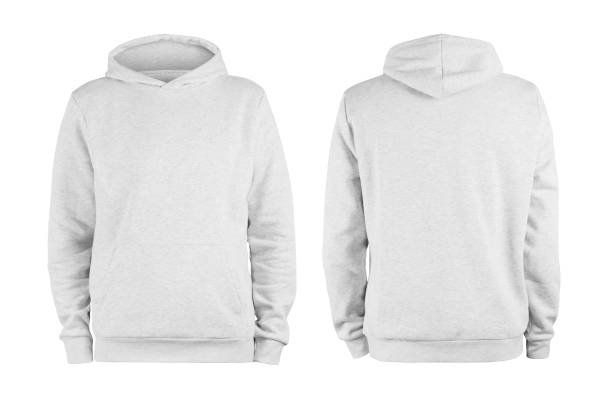Hoodies and athletic sweatshirts serve similar purposes, but the choice of fabric can make a significant difference. Hoodies can be made from a variety of materials, including cotton, polyester, and wool, each offering unique benefits to meet different consumer needs. Selecting the right fabric not only affects comfort and durability but also determines how well the hoodie performs during various activities.
The choice of material is crucial in the design and production of hoodies, as it directly impacts the overall quality and market competitiveness of the product. To ensure your hoodies capture the attention of consumers, the use of high-quality fabrics is essential.
In the following sections, we will explore the primary fabric types used in hoodies, helping you select a style that is both fashionable and functional. Whether you’re looking for a lightweight layering piece, a thick, warm option, or a breathable style designed for athletic pursuits, you’ll find the perfect balance between style and performance to enjoy for years to come.
Cotton: The Timeless Choice for Hoodies

When it comes to hoodie materials, cotton remains the classic option for good reason. Its unique properties make it an ideal choice for a comfortable and versatile garment.
Key Features of Cotton Hoodies:
- Soft and Comfortable: Cotton hoodies offer an unparalleled softness that feels gentle against the skin, making them perfect for everyday wear or lounging.
- Breathable: One of the standout qualities of cotton is its breathability. This allows for excellent air circulation, keeping you comfortable in a range of temperatures, from cool mornings to warmer afternoons.
- Moisture-Wicking: Cotton naturally absorbs moisture and sweat, helping to keep your body dry and comfortable during activities, whether you’re working out or simply enjoying a casual day out.
- Easy Care: Cotton hoodies are typically machine washable and durable, requiring no special maintenance, which adds to their appeal for busy lifestyles.
For those seeking a lightweight option suitable for layering or breezy summer evenings, thinner cotton knits or interlock fabrics are ideal. Conversely, for a cozier experience, medium-weight fleece or brushed cotton is recommended. Blends, such as cotton-polyester, can also enhance durability and elasticity, making them practical for active wear.
Premium Options: Supima and Pima Cotton
If you’re in search of an exceptionally soft and high-quality hoodie, consider Pima or Supima cotton. Pima cotton is sourced from a plant that produces extra-long fibers, leading to a smoother and softer fabric. Supima cotton, an even higher grade, is made from the longest and finest cotton fibers, ensuring that garments made from it are luxurious to the touch. While these options may come at a higher price point, the comfort and quality they provide are well worth the investment.
Whether you’re looking for a basic everyday hoodie or a lavishly soft option for those chilly nights, cotton stands out as the premier fabric choice. With its remarkable versatility, comfort, and ease of care, cotton remains unriv
Polyester: An Economical Choice for Synthetic Fabrics

If you’re looking for an affordable and durable fabric, polyester is an excellent synthetic material for making hoodies.
Polyester is favored for its durability, wrinkle resistance, and ease of machine washing. Being a petroleum-based material, it is water- and stain-resistant, with the ability to dry quickly and resist fading, making it ideal for outdoor activities. The low price of polyester hoodies allows you to worry less about damage during washing.
However, polyester does have some downsides. Compared to natural fibers, polyester has lower softness and breathability, which can make it feel a bit stiff, especially in warmer weather. Additionally, polyester can generate static electricity, so it’s advisable to consider polyester-cotton blends or fabrics mixed with natural fibers like cotton for enhanced softness and breathability.
For hoodie manufacturers on a budget, basic polyester hoodies are essential wardrobe staples. Their durability and price advantage are unmatched. If comfort is a concern, consider polyester-cotton blends or polyester-wool options. Either way, polyester hoodies can accompany you through multiple seasons.
With proper care, a polyester hoodie can last for years. It’s recommended to wash in cold water and tumble dry on low to maintain its shape and size. Avoid using fabric softeners, as they can damage the water resistance. For stubborn stains, pre-treat before washing, and always check the label to ensure proper cleaning methods. With the right care, polyester hoodies will become your go-to casual wear.
Wool: The Ideal Choice for Warmth and Breathability in Winter

Wool is an excellent choice for hoodies, keeping you warm in cold weather. As a natural insulating material, wool helps to retain body heat while providing good breathability to regulate temperature.
If you’re looking for a comfortable hoodie, prioritize merino or lamb’s wool. Merino wool is especially soft and lightweight, preventing the itchy sensation often associated with wool.
Other advantages of wool hoodies include:
- Strong Durability: Wool fibers have natural elasticity, making them resistant to wear.
- Odor Resistance: Wool naturally inhibits bacteria growth, effectively preventing odors.
- Good Moisture Absorption: Wool can absorb up to 30% of moisture without feeling wet.
- Eco-Friendly and Sustainable: Wool is a renewable material, aligning with sustainability principles.
Wool hoodies are best suited for winter wear, but they require regular dry cleaning or hand washing to avoid shrinkage, which may be slightly inconvenient. Additionally, due to wool’s excellent insulation, it may not be suitable for warmer weather.
In winter, wool hoodies are an ideal choice. Opt for medium to heavy-weight wool fabric with a loose and comfortable design, and with proper care, this hoodie will become your best companion for winters to come.
Fleece: The Ultimate in Softness and Comfort
Fleece is one of the softest and most comfortable materials for hoodies, offering moderate insulation and warmth, made from polyester fibers.
Fleece hoodies are perfect for casual wear on cooler days, being both comfortable and breathable, suitable for relaxing at home or going out. Fleece comes in various thicknesses, with lighter options for spring and autumn, and heavier versions for winter.
Fleece is durable and resistant to pilling, with moisture-wicking properties that can keep you dry and warm. However, fleece is not completely waterproof and may become saturated in heavy rain.
Fleece hoodies are typically reasonably priced and easy to maintain, machine washable, and suitable for low-temperature tumble drying without damaging the fabric.
Many renowned brands like The North Face, Patagonia, and Columbia offer high-quality fleece hoodies that combine comfort with style.
If you want a warm, soft, and casual hoodie, fleece is undoubtedly an excellent choice. For better wind and rain protection, consider a water-resistant fleece hoodie or layer it with other outerwear. A fleece hoodie will become a staple in your wardrobe, accompanying you through multiple seasons.
Cashmere: A Blend of Luxury and Supremely Soft Comfort
Cashmere is considered a luxurious fiber for obvious reasons. It’s not only incredibly soft and lightweight but also offers excellent warmth and durability, albeit at a higher price point.
Cashmere hoodies are made from the delicate fibers of cashmere goats, which are exceptionally soft and warm. A hoodie made from 100% cashmere will keep you warm while preventing overheating. The softness of cashmere is unmatched and only gets softer with washing.
If you seek ultimate comfort and are willing to pay a premium for quality, cashmere is the ideal choice for a hoodie. Look for labels that indicate “100% Cashmere” to ensure you’re getting the highest quality. Cashmere blends (containing 10-30% cashmere) may be more affordable but can be slightly inferior in softness and warmth.
With proper care—such as hand washing, air drying, and occasional professional cleaning—a high-quality 100% cashmere hoodie can last for years. However, cashmere is still a delicate natural fiber, so take care during drying and storage to avoid pilling or other damage.
While cashmere hoodies are an investment, their unparalleled softness and comfort make them worth it for many. If you’re looking for an ultra-luxurious hoodie and are willing to spend more for a quality product, then 100% cashmere is undoubtedly the perfect choice. If you want a softer fabric at a reasonable price, a cashmere blend hoodie can also meet your needs and budget.
Are Hoodies Suitable for Winter Wear?

- Cotton: A popular hoodie fabric, pure cotton is comfortable but may not be warm enough in winter. Look for heavier cotton hoodies, like those with fleece lining or a heavier knit fabric. Cotton-polyester blends offer better warmth than pure cotton.
- Wool: Wool hoodies are ideal for winter wear. Wool is lightweight, warm, and has good insulation properties. For chilly days, opt for medium-weight or heavy-weight wool hoodies that are breathable and comfortable to wear.
- Fleece: Fleece is one of the best insulating materials, able to keep you warm even in wet conditions. Fleece is a popular choice for hoodies and thermal wear. While fleece hoodies may be on the pricier side, they offer great warmth. For those sensitive to fleece, consider blended options that combine fleece with synthetic fibers for added comfort.
- Down or Synthetic Insulation: Some hoodies include down or synthetic insulation, such as lightweight down jackets. These offer significant warmth in cold winter months, but may lack breathability during high-intensity activities. For down, look for fill power of at least 600, while common synthetic insulation includes Thinsulate, PrimaLoft, and Polyfill.
Wool, fleece, and insulated hoodies are all excellent choices for winter wear, depending on the level of warmth you require. Pair them with a waterproof winter coat for optimal warmth.
What Materials Are Hoodies Made From?

Hoodies come in various materials, primarily including the following:
- Cotton: Comfortable and breathable, suitable for everyday wear, but warmth may be lacking.
- Polyester: Durable and wrinkle-resistant, reasonably priced, ideal for outdoor activities, but has lower breathability.
- Wool: Excellent warmth, soft, and comfortable, great for cold weather, but requires special care.
- Fleece: Lightweight and soft, great for casual wear, but not completely waterproof.
- Cashmere: Luxurious and extremely soft, but tends to be more expensive and requires careful handling.
By selecting the right fabric based on your needs, you can find a hoodie that meets your comfort and functional requirements.
Conclusion
As you embark on your journey to establish a hoodie business, it’s essential to grasp the various fabrics that contribute to the warmth and functionality of hoodies. Understanding the unique properties of materials such as cotton, polyester, fleece, and wool allows you to cater to a diverse range of customer preferences. Whether your target audience seeks lightweight options for casual wear or workouts, versatile midweight styles, or robust heavyweight designs for cold winter days, making informed fabric choices will be crucial to your success.
The paramount factor in selecting the ideal fabric for hoodies lies in its ability to provide comfort while aligning with the intended use. Prioritize fabrics that enhance the wearing experience, ensuring they offer breathability, softness, and durability. To truly understand the tactile qualities of these materials, engage with them firsthand. Test different textiles in various settings to discover the perfect combination of comfort and performance. This thorough approach will not only elevate your product offering but also resonate with consumers seeking the ideal hoodie for their lifestyle.







